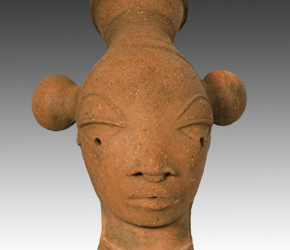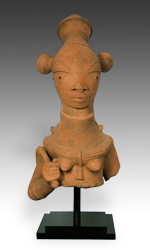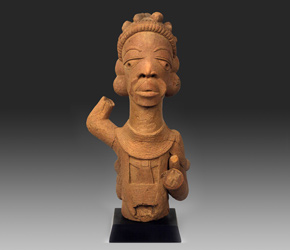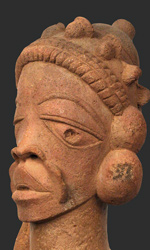Nok Terra Cotta
 |
|
"These ancient 2000 year old hollow form sculptures are designated 'Nok' – not named after the people that created them (because we're not exactly sure who that is) but after the village they were discovered in"
In 1943 a small terra cotta head was unearthed near the village of Nok on the Jos Plateau of Nigeria. It was determined to be over 2000 years old and became the oldest known figurative sculpture south of the Sahara. Since that time a great many heads have been found as well as depictions of animals, figures, and pottery shards at a wide range of sites around the area. Such works are identified simply as “Nok,” named after the village where the first piece was discovered. It has been discerned that this area was one of the earliest centers of terra cotta production in Africa; yet, despite the amount of material that has been unearthed, the Nok culture remains an enigma.
 |
|
Most Nok terra cotta sculpture is hollow and built like coiled pottery. The clay itself is finely worked to a resilient consistency and laced with gravel. One can almost think of it like cement, which was invented when gravel was mixed with sand. It is a testament to the technical ability of these ancient potters that these objects have survived for thousands of years; however, this is not to suggest the patina of the pottery has not changed over the course of time. The slip, the mixture of clay and water used to give pottery surfaces an even texture, has eroded on many Nok pieces leaving a grainy, pock marked exterior that is hardly reminiscent of the original surface. Most Nok sculpture found appears to have been portrait heads and fragmented bodies including busts. Pieces that have been recovered show that they were sculpted in standing, sitting, and genuflecting postures.
Nok sculptures are so highly varied they appear to have been individually modeled rather than cast from molds. Although terra cotta sculpture are usually formed by using additive techniques, or building up the finished form, many Nok pieces appear to have been sculpted in a subtractive manner similar to carving. This approach suggests some sort of wood carving tradition may have influenced the development of Nok sculpture; but it may be the other way around. Perhaps Nok sculpture influenced the development of various woodcarving traditions.
 |
 |
Stylistically, Nok sculpture places special emphasis upon the coiffures and adornment that must have been relevant to the people at the time of creation. The variety, beauty and inventiveness of the designs suggest the Nok culture was utterly devoted to body ornamentation. The heads of Nok sculpture are proportionally large relative to the bodies. In later African art traditions the creation of oversized heads often signified respect for intelligence, but it cannot be said with certainty this is true of Nok sculpture as well. Although every Nok sculpture is unique, certain stylistic traits are found in all the known work. Triangular eyes along with perforated pupils, noses, mouths and ears combine to present images of both sexes that are highly abstracted and compelling.
Nok terra cottas have such great sophistication; some scholars believe an as yet undiscovered culture must have preceded the Nok, a masterful group capable of passing on their specialized knowledge and artistic traditions. As yet, the existence of such a culture remains unproven. Nok terra cottas therefore occupy an important slot in the history of ancient art and African art in general, providing evidence that great artistic sophistication existed outside of Egypt elsewhere on the African continent thousands of years ago.
Download this Article: Nok Terra Cotta.pdf